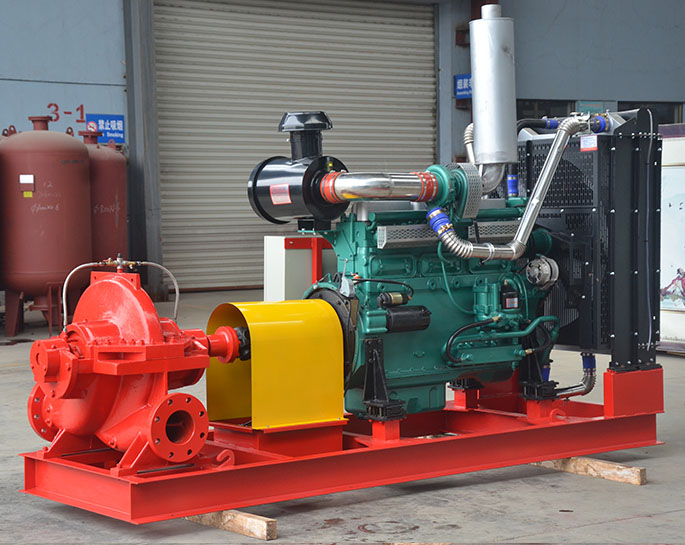What to do if the fire pump is corroded?
Aug 25, 2023
Share:
If you're dealing with a corroded fire pump, it's crucial to address the issue promptly to prevent further deterioration and ensure the pump's continued functionality during emergencies. Here's what you can do if the fire pump is corroded:
Isolate and Assess:
First, isolate the fire pump from the power source to ensure safety. Then, assess the extent of corrosion. Examine the pump casing, impellers, piping, and any other components for signs of corrosion.
Determine the Cause:
Identify the cause of the corrosion. Corrosion can be caused by various factors, such as exposure to moisture, harsh chemicals, environmental conditions, or improper maintenance. Understanding the root cause will help prevent future occurrences.
Cleaning and Removal of Corrosion:
Clean the corroded areas using appropriate methods:
Gently remove loose rust and corrosion using wire brushes, sandpaper, or abrasive pads.
For more stubborn corrosion, consider using chemical rust removers or rust converters. Follow the manufacturer's instructions and safety guidelines.
Inspect for Structural Integrity:
After cleaning, inspect the affected components for structural integrity. If the corrosion has significantly weakened the metal, replacement may be necessary.
Surface Preparation:
Prepare the cleaned surfaces for treatment or protection. This may involve sanding, cleaning with solvents, and ensuring a smooth and clean surface for coatings.
Protective Coatings:
Apply appropriate protective coatings to prevent future corrosion. Common options include:
Primer: Apply a suitable primer designed to prevent rust formation.
Paint: Use high-quality paint that provides corrosion resistance. Consider using epoxy-based paints for better protection.
Corrosion Inhibitors: Consider using corrosion-inhibiting products that can be applied to metal surfaces to slow down the corrosion process.
Galvanizing or Zinc Coating: For certain components, applying a galvanized or zinc coating can provide excellent corrosion protection.
Regular Maintenance:
Implement a regular maintenance schedule to prevent corrosion from reoccurring. Regularly inspect and touch up coatings, especially in areas prone to moisture or chemical exposure.
Environmental Controls:
If possible, control the environment around the fire pump to minimize corrosion risk. Maintain proper ventilation, humidity control, and protection from corrosive substances.
Consider Upgrades:
If the corrosion is severe and recurring, consider upgrading to more corrosion-resistant materials for components like impellers, casings, and piping.
Consult Professionals:
If you're unsure about how to effectively address corrosion or if the corrosion is extensive, it's recommended to consult with professionals who specialize in pump maintenance, corrosion prevention, and fire protection systems.
Remember that addressing corrosion is essential not only for the pump's functionality but also for the overall safety of your fire protection system. Regular maintenance, proper coatings, and vigilant monitoring can help extend the lifespan of the fire pump and ensure its reliability.

Isolate and Assess:
First, isolate the fire pump from the power source to ensure safety. Then, assess the extent of corrosion. Examine the pump casing, impellers, piping, and any other components for signs of corrosion.
Determine the Cause:
Identify the cause of the corrosion. Corrosion can be caused by various factors, such as exposure to moisture, harsh chemicals, environmental conditions, or improper maintenance. Understanding the root cause will help prevent future occurrences.
Cleaning and Removal of Corrosion:
Clean the corroded areas using appropriate methods:
Gently remove loose rust and corrosion using wire brushes, sandpaper, or abrasive pads.
For more stubborn corrosion, consider using chemical rust removers or rust converters. Follow the manufacturer's instructions and safety guidelines.
Inspect for Structural Integrity:
After cleaning, inspect the affected components for structural integrity. If the corrosion has significantly weakened the metal, replacement may be necessary.
Surface Preparation:
Prepare the cleaned surfaces for treatment or protection. This may involve sanding, cleaning with solvents, and ensuring a smooth and clean surface for coatings.
Protective Coatings:
Apply appropriate protective coatings to prevent future corrosion. Common options include:
Primer: Apply a suitable primer designed to prevent rust formation.
Paint: Use high-quality paint that provides corrosion resistance. Consider using epoxy-based paints for better protection.
Corrosion Inhibitors: Consider using corrosion-inhibiting products that can be applied to metal surfaces to slow down the corrosion process.
Galvanizing or Zinc Coating: For certain components, applying a galvanized or zinc coating can provide excellent corrosion protection.
Regular Maintenance:
Implement a regular maintenance schedule to prevent corrosion from reoccurring. Regularly inspect and touch up coatings, especially in areas prone to moisture or chemical exposure.
Environmental Controls:
If possible, control the environment around the fire pump to minimize corrosion risk. Maintain proper ventilation, humidity control, and protection from corrosive substances.
Consider Upgrades:
If the corrosion is severe and recurring, consider upgrading to more corrosion-resistant materials for components like impellers, casings, and piping.
Consult Professionals:
If you're unsure about how to effectively address corrosion or if the corrosion is extensive, it's recommended to consult with professionals who specialize in pump maintenance, corrosion prevention, and fire protection systems.
Remember that addressing corrosion is essential not only for the pump's functionality but also for the overall safety of your fire protection system. Regular maintenance, proper coatings, and vigilant monitoring can help extend the lifespan of the fire pump and ensure its reliability.







